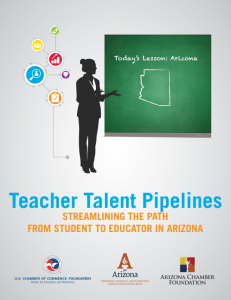 Talk to any rural district about challenges facing their school system and they’re likely to cite a teacher shortage. Recruiting and retaining high quality educators who are equipped to meet the demands of a 21st century classroom is one of the most pressing challenges the American education system faces today, affecting communities of all sizes and geographies. Crucially, Career Technical Education (CTE) classrooms – which demand highly-skilled teachers – are struggling to fill open positions.
Talk to any rural district about challenges facing their school system and they’re likely to cite a teacher shortage. Recruiting and retaining high quality educators who are equipped to meet the demands of a 21st century classroom is one of the most pressing challenges the American education system faces today, affecting communities of all sizes and geographies. Crucially, Career Technical Education (CTE) classrooms – which demand highly-skilled teachers – are struggling to fill open positions.
A new report from the U.S. Chamber of Commerce Foundation (USCCF), released this week, examines teacher recruitment practices from school districts in Arizona and finds that many schools struggle to find teachers that are adequately prepared to support the diversity of student needs. Part of this preparation gap is due to the lack of formal systems to communicate teacher supply needs and build pathways into the classroom. Recognizing parallels with other industry workforce shortages, USCCF developed a set of recommendations for school districts to expand the pool of quality teachers through a talent pipeline management strategy. Recommendations include:
- Schools should come together in groups to define collective demand for talent and define skills needed from candidates.
- Analyze current ways of sourcing teacher talent.
- Build and incentivize relationships with top talent providers.
These strategies aim to improve the quality and supply of the teaching workforce by streamlining the talent pipeline and increasing avenues of communication and collaboration from the preparation to the recruitment stage. In regions where teacher workforce gaps exist, states should consider strategies to reach potential teachers earlier in the pipeline and expand pathways into the profession.
Promising News for College Promise
In his 2015 State of the Union address, President Obama called on Congress and the states to provide tuition free community college for students in the U.S. This proposal was inspired in part by the Tennessee Promise program, which provides last-dollar scholarships to eligible students in the state. In the time since then, free community college programs have expanded significantly, encompassing a total of 150 programs across 37 states. Researchers at the University of Pennsylvania recently developed a web-based platform that maps and details each of these programs. Additionally, the College Promise Campaign — a national, non-partisan initiative to research and advocate for Promise programs — released its 2016 annual report, profiling pioneer and emerging programs across the states. One example is the Oakland Promise program, which aims to reach back to early learning years in order to create a college-going culture and provide college and career advising supports throughout the K-12 education system. Students who qualify for the scholarship program can receive up to $16,000 towards their postsecondary education.
On a related note, the College Board released its annual “Trends in College Pricing Report†and found that in 2016-17, the average net tuition and fees paid by two-year college students was $920 less than before the Great Recession (though costs have increased since 2011-12). Over roughly the same period, state and local appropriations for higher education declined 9 percent.
Odds and Ends
 Short on Talent. Manpower Group’s 2016/17 Talent Shortage Survey reports the highest global talent shortage since 2007, largely in the skilled trades, IT and sales industries. As a result, more than 50 percent of surveyed employers are training and developing existing staff in order to fill open positions.
Short on Talent. Manpower Group’s 2016/17 Talent Shortage Survey reports the highest global talent shortage since 2007, largely in the skilled trades, IT and sales industries. As a result, more than 50 percent of surveyed employers are training and developing existing staff in order to fill open positions.
Data Linkages. All 50 states plus D.C. have the ability to connect data between systems — but only 17 (plus D.C.) have a full P20W system. That’s according to the Education Commission of the States’ 50-state comparison of statewide longitudinal data systems.
For the Equity Toolbox. The National Skills Coalition released a set of five policy toolkits with resources and recommendations for adopting and aligning policies to expand equitable access to training, credentials and careers. Toolkits include stackable credentials and integrating education and training, among others.
Standards for CBE. C-BEN, a coalition of more than 30 colleges offering competency-based education (CBE) programs, released draft quality standards for CBE. The standards will be finalized early next year and focus on eight areas, including clear, measurable, meaningful and complete competencies and credential-level assessment strategy with robust implementation.
Austin Estes, Policy Associate

